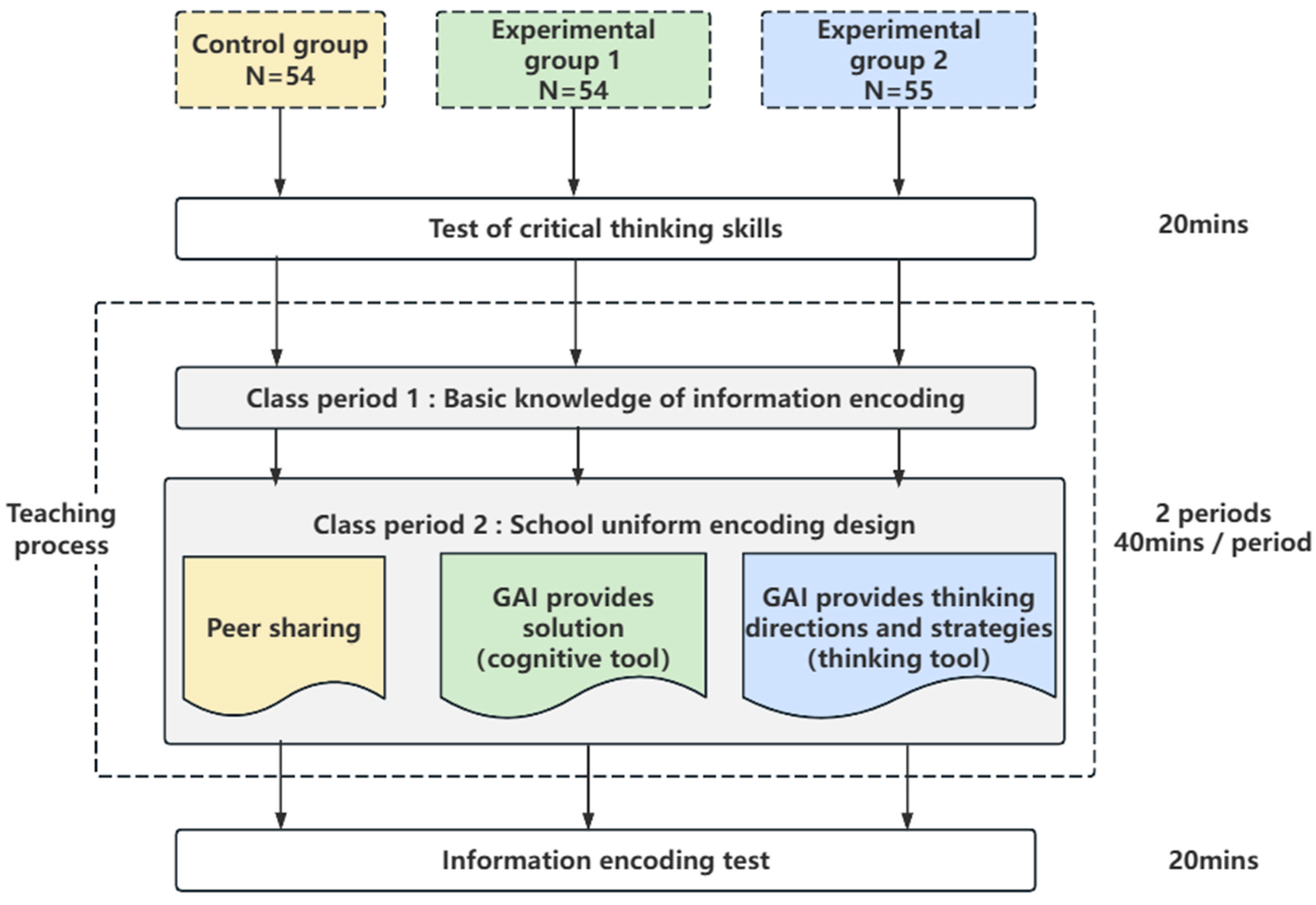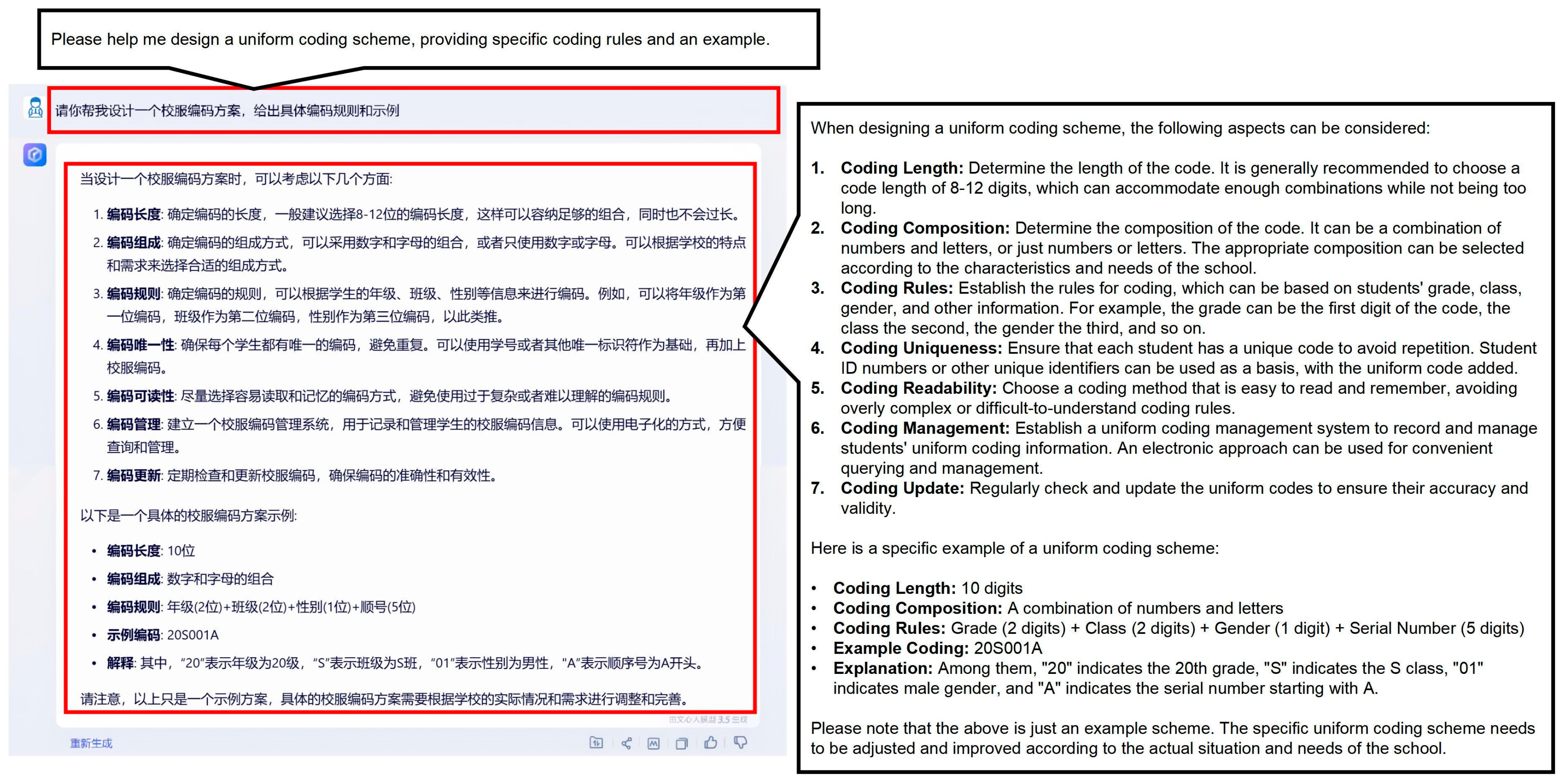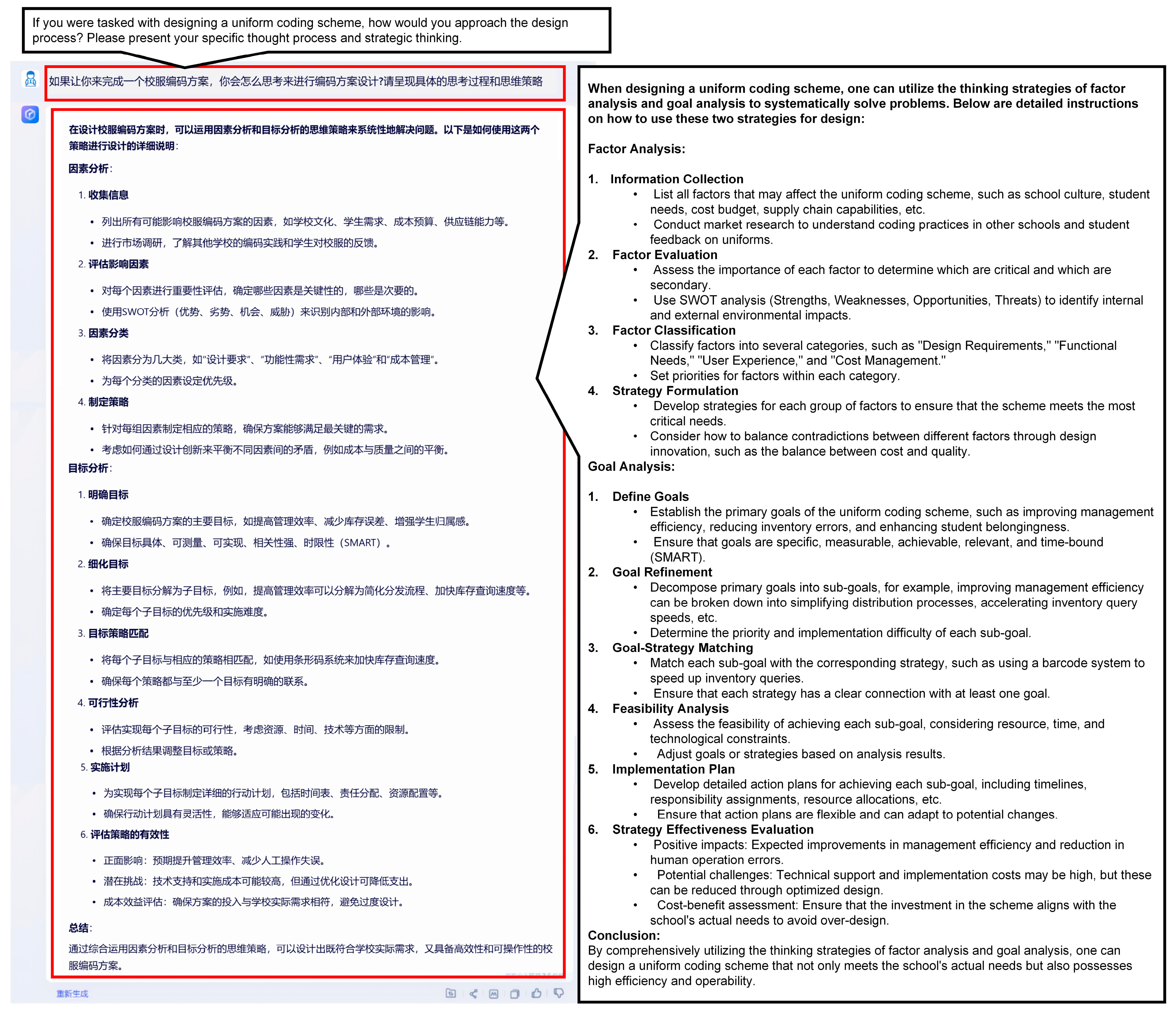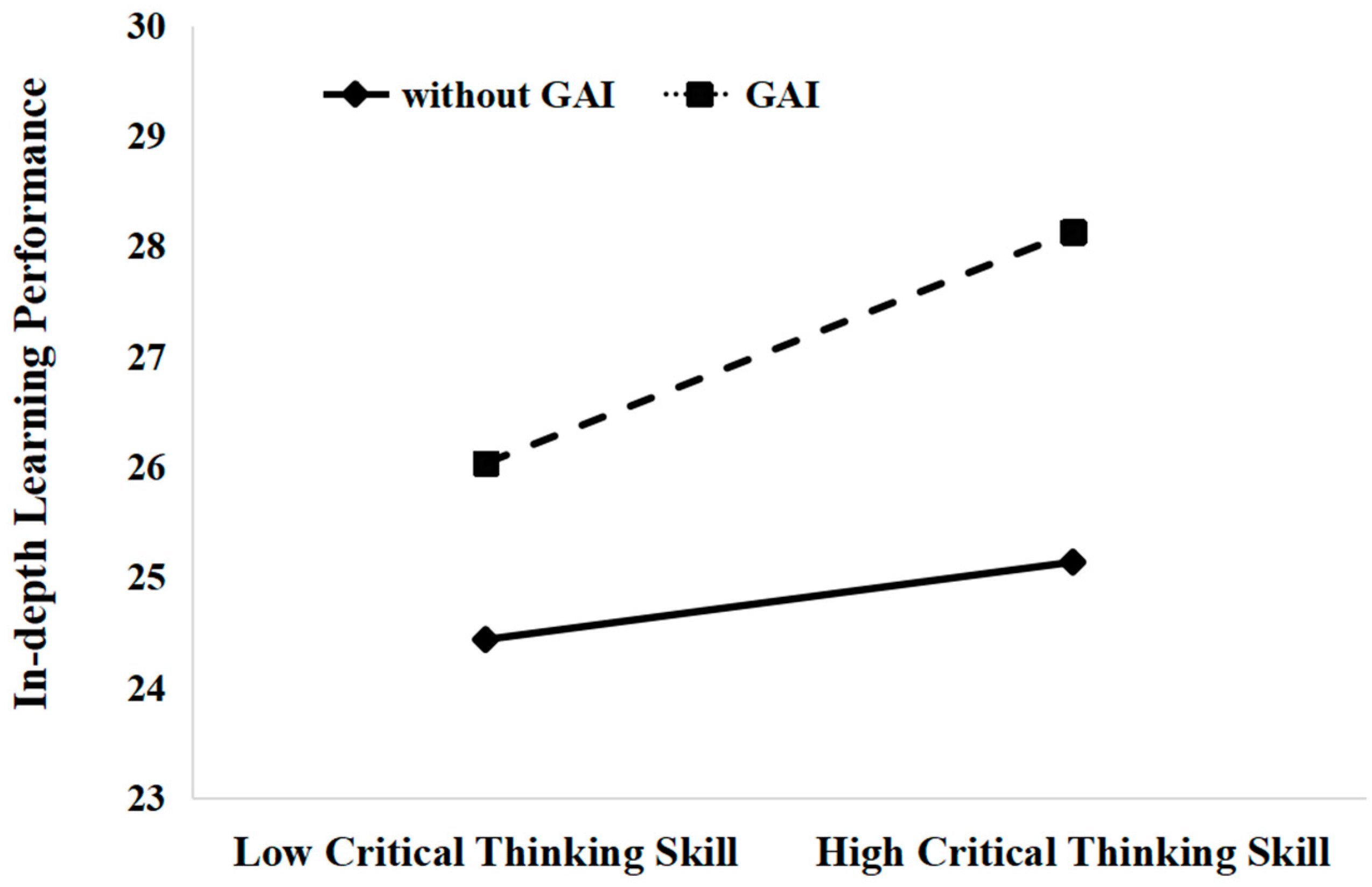Generative Artificial Intelligence Amplifies the Role of Critical Thinking Skills and Reduces Reliance on Prior Knowledge While Promoting In-Depth Learning
Abstract
1. Introduction
2. Literature Review
2.1. In-Depth Learning
2.2. GAI and Its Use in Education
2.3. Variables Influencing the Effect of In-Depth Learning in the GAI Context
2.3.1. Prior Knowledge
2.3.2. Critical Thinking
2.4. GAI for In-Depth Learning and Related Skills
2.5. The Present Study
3. Methodology
3.1. Context and Participants
3.2. Experiment Design
3.3. Materials and Instruments
3.3.1. GAI-Generated Materials
3.3.2. In-Depth Learning Performance Measurement
3.3.3. Prior Knowledge Test
3.3.4. Thinking Quality Test for Pupils (Short Version)
3.4. Data Analysis
4. Results
4.1. Effect of Use of GAI on In-Depth Learning Performance
4.2. Factors Influencing In-Depth Learning Performance
4.3. Interactive Effects Between Critical Thinking Skills, Prior Knowledge, and the Use of GAI on In-Depth Learning
5. Discussion
5.1. The Use of GAI Promotes In-Depth Learning
5.2. GAI Amplified the Role of Critical Thinking Skills in In-Depth Learning
5.3. GAI Weakened the Role of Prior Knowledge in In-Depth Learning
5.4. Implication for Practice
5.5. Limitations and Future Work
6. Conclusions
Supplementary Materials
Author Contributions
Funding
Institutional Review Board Statement
Informed Consent Statement
Data Availability Statement
Conflicts of Interest
References
- Aderibigbe, S. A. (2021). Can online discussions facilitate deep learning for students in General Education? Heliyon, 7(3), e06414. [Google Scholar] [CrossRef] [PubMed]
- Adiguzel, T., Kaya, M. H., & Cansu, F. K. (2023). Revolutionizing education with AI: Exploring the transformative potential of ChatGPT. Contemporary Educational Technology, 15(3), ep429. [Google Scholar] [CrossRef]
- Ausubel, D. P. (1963). Psychology of meaningful verbal learning: An introduction to school learning. Grune & Stratton. [Google Scholar]
- Baidoo-Anu, D., & Ansah, L. (2023). Education in the era of generative Artificial Intelligence (AI): Understanding the potential benefits of ChatGPT in promoting teaching and learning. Journal of AI, 7, 52–62. [Google Scholar] [CrossRef]
- Bhattacharyya, M., Miller, V. M., Bhattacharyya, D., & Miller, L. E. (2023). High rates of fabricated and inaccurate references in ChatGPT-generated medical content. Cureus, 15(5), e39238. [Google Scholar] [CrossRef]
- Biggs, J., & Collis, K. (1989). Towards a model of school-based curriculum development and assessment using the SOLO taxonomy. Australian Journal of Education, 33(2), 151–163. [Google Scholar] [CrossRef]
- Biggs, J., Kember, D., & Leung, D. Y. P. (2001). The revised two-factor study process questionnaire: R-SPQ-2F. British Journal of Educational Psychology, 71(1), 133–149. [Google Scholar] [CrossRef] [PubMed]
- Bonsaksen, T. (2018). Deep, surface, or both? A study of occupational therapy students’ learning concepts. Occupational Therapy International, 2018, 3439815. [Google Scholar] [CrossRef] [PubMed]
- Bu, C., Li, S., Yang, H., Wang, L., Zhang, T., & Zhang, S. (2023). Research on the internal mechanism, model, and effectiveness of online deep learning. Frontiers of Education in China, 18(3), 310–331. [Google Scholar]
- Cai, H., & Gu, X. (2019). Supporting collaborative learning using a diagram-based visible thinking tool based on cognitive load theory. British Journal of Educational Technology, 50(5), 2329–2345. [Google Scholar] [CrossRef]
- Collins, G. W., & Knoetze, J. G. (2014). Information communication technology in the form of an expert system shell as a cognitive tool to facilitate higher-order thinking. Australasian Journal of Educational Technology, 30(4), 455–471. [Google Scholar] [CrossRef]
- Darvishi, A., Khosravi, H., Sadiq, S., Gašević, D., & Siemens, G. (2024). Impact of AI assistance on student agency. Computers & Education, 210, 104967. [Google Scholar] [CrossRef]
- Dergaa, I., Chamari, K., Zmijewski, P., & Ben Saad, H. (2023). From human writing to artificial intelligence generated text: Examining the prospects and potential threats of ChatGPT in academic writing. Biology of Sport, 40(2), 615–622. [Google Scholar] [CrossRef]
- Dochy, F., Segers, M., & Buehl, M. M. (1999). The relation between assessment practices and outcomes of studies: The case of research on prior knowledge. Review of Educational Research, 69(2), 145–186. [Google Scholar] [CrossRef]
- Dochy, F. J. R. C., Moerkerke, G., & Martens, R. (1996). Integrating assessment, learning and instruction: Assessment of domain-specific and domain transcending prior knowledge and progress. Studies in Educational Evaluation, 22(4), 309–339. [Google Scholar] [CrossRef]
- Drew, C. (2019). Re-examining cognitive tools: New developments, new perspectives, and new opportunities for educational technology research. Australasian Journal of Educational Technology, 35(2), 2. [Google Scholar] [CrossRef]
- Dwyer, C. P., Hogan, M. J., & Stewart, I. (2014). An integrated critical thinking framework for the 21st century. Thinking Skills and Creativity, 12, 43–52. [Google Scholar] [CrossRef]
- Ennis, R. H. (1985). A logical basis for measuring critical thinking skills. Educational leadership. Available online: https://www.semanticscholar.org/paper/A-Logical-Basis-for-Measuring-Critical-Thinking-Ennis/80a7c7d4a98987590751df4b1bd9adf747fd7aaa#cited-papers (accessed on 10 October 2024).
- Entwistle, N., & Ramsden, P. (1983). Understanding student learning. British Journal of Educational Studies, 32, 284. [Google Scholar] [CrossRef]
- Essel, H. B., Vlachopoulos, D., Tachie-Menson, A., Johnson, E. E., & Baah, P. K. (2022). The impact of a virtual teaching assistant (chatbot) on students’ learning in Ghanaian higher education. International Journal of Educational Technology in Higher Education, 19(1), 57. [Google Scholar] [CrossRef]
- Facione, N. C., Facione, P. A., & Sanchez, C. A. (1994). Critical thinking disposition as a measure of competent clinical judgment: The development of the California critical thinking disposition inventory. The Journal of Nursing Education. Available online: https://www.semanticscholar.org/paper/Critical-thinking-disposition-as-a-measure-of-the-Facione-Facione/1a9bb5050044ab0f93d69e626ca7d76d7903adc6 (accessed on 30 October 2024).
- Facione, P. A. (1990). Critical thinking: A statement of expert consensus for purposes of educational assessment and instruction. Research findings and recommendations. ERIC document reproduction service. California Academic Press. [Google Scholar]
- Fisher, A. (2001). Critical thinking: An introduction. Available online: https://www.semanticscholar.org/paper/Critical-Thinking:-An-Introduction-Fisher/de569975c5a43d063851a48f213c5f1edb013d09 (accessed on 30 October 2024).
- Ge, X., Turk, M., & Hung, W. (2019). Revisiting cognitive tools from a social and motivational perspective. Australasian Journal of Educational Technology, 35(2), 2. [Google Scholar] [CrossRef]
- Gökçearslan, Ş., Solmaz, E., & Karabulut Coşkun, B. (2019). Critical thinking and digital technologies: Concepts, methodologies, tools, and applications. In Rapid automation (pp. 1407–1433). IGI Global. [Google Scholar] [CrossRef]
- Habib, S., Vogel, T., Anli, X., & Thorne, E. (2024). How does generative artificial intelligence impact student creativity? Journal of Creativity, 34(1), 100072. [Google Scholar] [CrossRef]
- Halpern, D. F. (1998). Teaching critical thinking for transfer across domains: Disposition, skills, structure training, and metacognitive monitoring. American Psychologist, 53(4), 449–455. [Google Scholar] [CrossRef] [PubMed]
- Ineson, E. M., Jung, T., Hains, C., & Kim, M. (2013). The influence of prior subject knowledge, prior ability and work experience on self-efficacy. Journal of Hospitality, Leisure, Sport & Tourism Education, 12(1), 59–69. [Google Scholar] [CrossRef]
- Jo, H. (2024). From concerns to benefits: A comprehensive study of ChatGPT usage in education. International Journal of Educational Technology in Higher Education, 21(1), 35. [Google Scholar] [CrossRef]
- Johnson, W. L. (2023). How to harness generative AI to accelerate human learning. International Journal of Artificial Intelligence in Education, 34(3), 1287–1291. [Google Scholar] [CrossRef]
- Jonassen, D. H. (1995). Computers as cognitive tools: Learning with technology, not from technology. Journal of Computing in Higher Education, 6(2), 40–73. [Google Scholar] [CrossRef]
- Kasneci, E., Sessler, K., Küchemann, S., Bannert, M., Dementieva, D., Fischer, F., Gasser, U., Groh, G., Günnemann, S., Hüllermeier, E., Krusche, S., Kutyniok, G., Michaeli, T., Nerdel, C., Pfeffer, J., Poquet, O., Sailer, M., Schmidt, A., Seidel, T., … Kasneci, G. (2023). ChatGPT for good? On opportunities and challenges of large language models for education. Learning and Individual Differences, 103, 102274. [Google Scholar] [CrossRef]
- Kieser, F., Wulff, P., Kuhn, J., & Küchemann, S. (2023). Educational data augmentation in physics education research using ChatGPT. arXiv, arXiv:2307.14475. [Google Scholar] [CrossRef]
- Koo, Y. M., & Seo, J.-H. (2012). Development of six thinking hats online synchronous discussion tool to facilitate structured interaction and communication. Journal of the Korean Association of information Education, 16(1), 107–121. [Google Scholar]
- Korucu-Kiş, S. (2024). Zone of proximal creativity: An empirical study on EFL teachers’ use of ChatGPT for enhanced practice. Thinking Skills and Creativity, 54, 101639. [Google Scholar] [CrossRef]
- Krashen, S. (1985). The input hypothesis: Issues and implications. Longman Group. [Google Scholar]
- Krause, S., Panchal, B. H., & Ubhe, N. (2025, July 29–31). The evolution oflearning: Assessing thetransformative impact ofgenerative AI on higher education. International Conference on Artificial Intelligence in Education Technology, Munich, Germany. [Google Scholar]
- Kuhn, D. (1993). Connecting scientific and informal reasoning. Merrill-Palmer quarterly. Available online: https://www.semanticscholar.org/paper/Connecting-scientific-and-informal-reasoning-Kuhn/dac0513715afb524a926c2714869d37c4c645a37 (accessed on 25 October 2024).
- Lai, E. R., Bay-Borelli, M., Kirkpatrick, R., Lin, A., & Wang, C. (2011). Critical thinking: A literature review research report. Available online: https://www.semanticscholar.org/paper/Critical-Thinking%3A-A-Literature-Review-Research-Lai-Bay-Borelli/ac07dd13e9ecea98bc14478126afc386b169b5cc (accessed on 30 October 2024).
- Lajoie, S. P., & Derry, S. J. (1993). Computers as cognitive tools (1st ed.). Available online: https://www.taylorfrancis.com/books/edit/10.4324/9780203052594/computers-cognitive-tools-susanne-lajoie-sharon-derry (accessed on 30 October 2024).
- Lee, H.-Y. (2024). Empowering ChatGPT with guidance mechanism in blended learning: Effect of self-regulated learning, higher-order thinking skills, and knowledge construction. International Journal of Educational Technology in Higher Education, 21(1), 1–28. [Google Scholar] [CrossRef]
- Li, Z., Liu, D., Li, N., Li, F., & Yang, Y. (2018). Research on the influencing factors of in-depth learning. Modern Educational Technology, 28(12), 55–61. [Google Scholar]
- Liang, W., & Wu, Y. (2024). Exploring the use of chatgpt to foster efl learners’ critical thinking skills from a post-humanist perspective. Thinking Skills and Creativity, 54, 101645. [Google Scholar] [CrossRef]
- Liu, M., Horton, L. R., Corliss, S. B., Svinicki, M. D., Bogard, T., Kim, J., & Chang, M. (2009). Students’ problem solving as mediated by their cognitive tool use: A study of tool use patterns. Journal of Educational Computing Research, 40(1), 111–139. [Google Scholar] [CrossRef]
- Lo, C. K. (2023). What is the impact of ChatGPT on education? A rapid review of the literature. Education Sciences, 13(4), 410. [Google Scholar] [CrossRef]
- Long, T., Su, G., Wang, Z., & Zeng, Q. (2020, July 21–24). The effect of thinking tools on the argumentation skills of pre-service science teachers in flipped learning. 2020 International Symposium on Educational Technology (ISET) (pp. 48–52), Bangkok, Thailand. [Google Scholar] [CrossRef]
- Marton, F., & Säljö, R. (1976). On qualitative differences in learning: I—Outcome and process. British Journal of Educational Psychology, 46(1), 4–11. [Google Scholar] [CrossRef]
- Milano, S., McGrane, J. A., & Leonelli, S. (2023). Large language models challenge the future of higher education. Nature Machine Intelligence, 5(4), 333–334. [Google Scholar] [CrossRef]
- National Research Council. (2012). Education for life and work: Developing transferable knowledge and skills in the 21st century. National Academies Press. [Google Scholar] [CrossRef]
- Noone, T., & Seery, A. (2018). Critical thinking dispositions in undergraduate nursing students: A case study approach. Nurse Education Today, 68, 203–207. [Google Scholar] [CrossRef]
- O’Donnell, A. M., & Dansereau, D. F. (2000). Interactive effects of prior knowledge and material format on cooperative teaching. The Journal of Experimental Education, 68(2), 101–118. [Google Scholar] [CrossRef]
- Park, S. I., Lee, G., & Kim, M. (2009). Do students benefit equally from interactive computer simulations regardless of prior knowledge levels? Computers & Education, 52(3), 649–655. [Google Scholar] [CrossRef]
- Perera Molligoda Arachchige, A. S. (2023). Large language models (LLM) and ChatGPT: A medical student perspective. European Journal of Nuclear Medicine and Molecular Imaging, 50(8), 2248–2249. [Google Scholar] [CrossRef]
- Piaget, J. (1971). The theory of stages in cognitive development. In Measurement and piaget. McGraw-Hill. [Google Scholar]
- Sardi, J., Darmansyah, Candra, O., Yuliana, D. F., Habibullah, Yanto, D. T. P., & Eliza, F. (2025). How generative AI influences students’ self-regulated learning and critical thinking skills? A systematic review. International Journal of Engineering Pedagogy (iJEP), 15(1), 94–108. [Google Scholar] [CrossRef]
- Savchenko, S., Shekhavtsova, S. O., & Zaselskiy, V. (2020). The development of students’ critical thinking in the context of information security. In O. Y. Burov, & A. E. Kiv (Eds.), Proceedings of the 3rd international workshop on augmented reality in education (aredu 2020) (Vol. 2731, pp. 383–399). Rwth Aachen. Available online: https://www.semanticscholar.org/paper/The-development-of-students%27-critical-thinking-in-Savchenko-Shekhavtsova/ec92647a6c387faceb8736223cf0771126264fc8 (accessed on 24 October 2024).
- Shoufan, A. (2023). Can students without prior knowledge use ChatGPT to answer test questions? An empirical study. ACM Transactions on Computing Education, 23(4), 1–29. [Google Scholar] [CrossRef]
- Simonsmeier, B. A., Flaig, M., Deiglmayr, A., Schalk, L., & Schneider, M. (2022). Domain-specific prior knowledge and learning: A meta-analysis. Educational Psychologist, 57(1), 31–54. [Google Scholar] [CrossRef]
- Su, Y., Lin, Y., & Lai, C. (2023). Collaborating with ChatGPT in argumentative writing classrooms. Assessing Writing, 57, 100752. [Google Scholar] [CrossRef]
- Sugden, N., Brunton, R., MacDonald, J., Yeo, M., & Hicks, B. (2021). Evaluating student engagement and deep learning in interactive online psychology learning activities. Australasian Journal of Educational Technology, 37(2), 45–65. [Google Scholar] [CrossRef]
- Sweller, J. (2010). Element interactivity and intrinsic, extraneous, and germane cognitive load. Educational Psychology Review, 22(2), 123–138. [Google Scholar] [CrossRef]
- Urban, M., Děchtěrenko, F., Lukavský, J., Hrabalová, V., Svacha, F., Brom, C., & Urban, K. (2024). ChatGPT improves creative problem-solving performance in university students: An experimental study. Computers & Education, 215, 105031. [Google Scholar] [CrossRef]
- Wang, J., Li, H., & Li, Z. (2020). Research on Influencing factors and model construction of college students’ deep learning under the environment of “Internet +”. Lifelong Education Research, 31(04), 44–54. [Google Scholar] [CrossRef]
- Willingham, D. T. (2008). Critical thinking: Why is it so hard to teach? Arts Education Policy Review, 109(4), 21–32. [Google Scholar] [CrossRef]
- Wilson, R. C., Shenhav, A., Straccia, M., & Cohen, J. D. (2019). The Eighty Five Percent Rule for optimal learning. Nature Communications, 10(1), 1. [Google Scholar] [CrossRef]
- Wu, T., Lee, H., Chen, P., Lin, C., & Huang, Y. (2024). Integrating peer assessment cycle into ChatGPT for STEM education: A randomised controlled trial on knowledge, skills, and attitudes enhancement. Journal of Computer Assisted Learning, 41, jcal.13085. [Google Scholar] [CrossRef]
- Yan, L., Sha, L., Zhao, L., Li, Y., Martinez-Maldonado, R., Chen, G., Li, X., Jin, Y., & Gašević, D. (2024). Practical and ethical challenges of large language models in education: A systematic scoping review. British Journal of Educational Technology, 55(1), 90–112. [Google Scholar] [CrossRef]
- Yu, W., & Wu, Y. (2024). ChatGPT and Higher Education in China: Opportunities and Challenges. In M. A. Peters, & R. Heraud (Eds.), Encyclopedia of educational innovation. Springer. [Google Scholar] [CrossRef]
- Yuan, Y., Li, H., & Sawaengdist, A. (2024). The impact of ChatGPT on learners in English academic writing: Opportunities and challenges in education. Language Learning in Higher Education, 14(1), 41–56. [Google Scholar] [CrossRef]
- Zhao, G., Duan, Y., Zhao, X., & Li, X. (2022). Cognitive tools and thinking tools towards intelligent learning. Modern Distance Education Research, 34(03), 96–103. [Google Scholar]




| Dimensions | ICT as Cognitive Tools | ICT as Thinking Tools |
|---|---|---|
| Theoretical basis | Social constructivism theory and distributed cognition theory | Cognitive constructivism theory |
| Definition | Mental or computational devices that support, guide, or expand the cognitive processes of users | Thinking strategies or methods used to guide the direction and focus of users’ thinking |
| Action mechanism | Reducing lower-level cognitive load through external tools, allowing learners to allocate more cognitive resources to higher-order cognitive activities, creating conditions for in-depth thinking by learners | Providing thinking strategies or methods to guide or expand the internal meaning construction of learners, directly enhancing the learners’ thinking abilities |
| Essential characteristics | Knowledge representation, interactivity, and distributed cognition | Internalizability of thinking strategies carried by tools |
| Examples | Interactive Simulations (PhET): allowing students to experiment with scientific concepts virtually, represent abstract knowledge in a concrete way, and make abstract concepts more tangible | Problem Decomposition Method: guiding students to break down complex problems into smaller, manageable parts. It involves defining the core issue, decomposing it logically, assigning priorities, and solving each part step-by-step before integrating the solutions. |
| GAI as Cognitive Tools | GAI as Thinking Tools |
|---|---|
|
|
|
|
|
|
|
|
| Variable | Group | N | M | SD | F | Sig. |
|---|---|---|---|---|---|---|
| Knowledge Retention | Control Group | 37 | 21.380 | 3.419 | 1.360 | 0.260 |
| Experimental Group 1 | 41 | 21.340 | 3.490 | |||
| Experimental Group 2 | 48 | 22.290 | 2.361 | |||
| Knowledge Transfer | Control Group | 37 | 1.959 | 1.969 | 12.797 | 0.001 |
| Experimental Group 1 | 41 | 4.329 | 2.097 | |||
| Experimental Group 2 | 48 | 3.510 | 2.177 |
| Variable | Group (I) | Group (J) | Mean Difference (I–J) | SD | Sig. | 95% CI | |
|---|---|---|---|---|---|---|---|
| Lower | Upper | ||||||
| Knowledge Transfer | Control Group | Experimental Group 1 | −2.3698 ** | 0.4743 | 0 | −3.309 | −1.431 |
| Experimental Group 2 | −1.551 * | 0.4576 | 0.001 | −2.457 | −0.645 | ||
| Experimental Group 1 | Control Group | 2.3698 ** | 0.4743 | 0 | 1.431 | 3.309 | |
| Experimental Group 2 | 0.8189 | 0.4449 | 0.068 | −0.062 | 1.699 | ||
| Experimental Group 2 | Control Group | 1.551 * | 0.4576 | 0.001 | 0.645 | 2.457 | |
| Experimental Group 1 | −0.8189 | 0.4449 | 0.068 | −1.699 | 0.062 | ||
| In-Depth Learning Performance | Model 1 | Model 2 | Model 3 | Model 4 | Model 5 | |||||
|---|---|---|---|---|---|---|---|---|---|---|
| β | t | β | t | β | t | β | t | β | t | |
| Critical thinking skills | 0.315 ** | 3.675 | 0.237 * | 2.617 | 0.224 * | 2.478 | 0.237 ** | 2.717 | 0.222 * | 2.533 |
| Prior knowledge | 0.212 * | 2.339 | 0.150 | 1.536 | 0.156 | 1.646 | 0.214 * | 2.030 | ||
| GAI | 0.148 | 1.580 | 0.200 * | 2.178 | 0.214 * | 2.315 | ||||
| Critical thinking skills * GAI | 0.260 ** | 3.142 | 0.230 ** | 2.661 | ||||||
| Prior knowledge * GAI | 0.123 | 1.237 | ||||||||
| R2 | 0.099 | 0.138 | 0.155 | 0.219 | 0.229 | |||||
| ΔR2 | 0.092 | 0.123 | 0.134 | 0.193 | 0.197 | |||||
| F | 13.509 ** | 5.472 * | 2.495 | 9.969 ** | 1.530 | |||||
| VIF max | 1.000 | 1.157 | 1.372 | 1.372 | 1.718 | |||||
| Critical Thinking Skills | Effect | SE | t | p | LLCI | ULCI |
|---|---|---|---|---|---|---|
| −3.2496 (M − 1SD) | 0.0271 | 0.9271 | 0.0292 | 0.9768 | −1.8083 | 1.8624 |
| 0 (M) | 2.2947 | 0.7468 | 3.0726 | 0.0026 | 0.8163 | 3.7732 |
| 3.2496 (M + 1SD) | 4.5624 | 1.1379 | 4.0094 | 0.0001 | 2.3098 | 6.8151 |
Disclaimer/Publisher’s Note: The statements, opinions and data contained in all publications are solely those of the individual author(s) and contributor(s) and not of MDPI and/or the editor(s). MDPI and/or the editor(s) disclaim responsibility for any injury to people or property resulting from any ideas, methods, instructions or products referred to in the content. |
© 2025 by the authors. Licensee MDPI, Basel, Switzerland. This article is an open access article distributed under the terms and conditions of the Creative Commons Attribution (CC BY) license (https://creativecommons.org/licenses/by/4.0/).
Share and Cite
Zhao, G.; Sheng, H.; Wang, Y.; Cai, X.; Long, T. Generative Artificial Intelligence Amplifies the Role of Critical Thinking Skills and Reduces Reliance on Prior Knowledge While Promoting In-Depth Learning. Educ. Sci. 2025, 15, 554. https://doi.org/10.3390/educsci15050554
Zhao G, Sheng H, Wang Y, Cai X, Long T. Generative Artificial Intelligence Amplifies the Role of Critical Thinking Skills and Reduces Reliance on Prior Knowledge While Promoting In-Depth Learning. Education Sciences. 2025; 15(5):554. https://doi.org/10.3390/educsci15050554
Chicago/Turabian StyleZhao, Guoqing, Haixi Sheng, Yaxuan Wang, Xiaohui Cai, and Taotao Long. 2025. "Generative Artificial Intelligence Amplifies the Role of Critical Thinking Skills and Reduces Reliance on Prior Knowledge While Promoting In-Depth Learning" Education Sciences 15, no. 5: 554. https://doi.org/10.3390/educsci15050554
APA StyleZhao, G., Sheng, H., Wang, Y., Cai, X., & Long, T. (2025). Generative Artificial Intelligence Amplifies the Role of Critical Thinking Skills and Reduces Reliance on Prior Knowledge While Promoting In-Depth Learning. Education Sciences, 15(5), 554. https://doi.org/10.3390/educsci15050554






